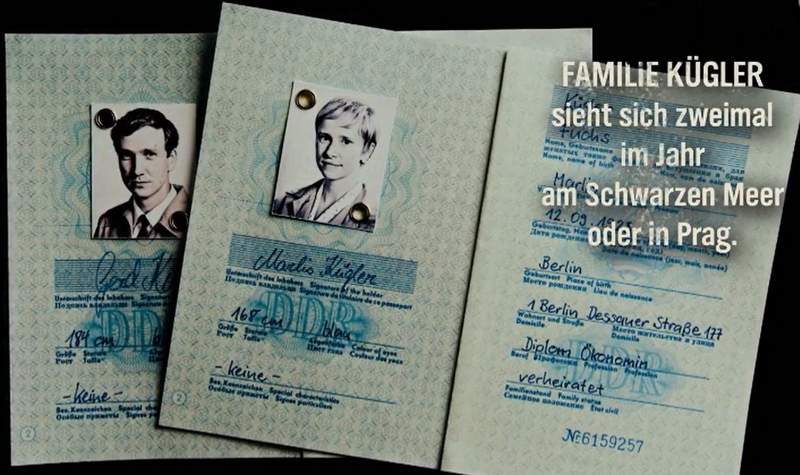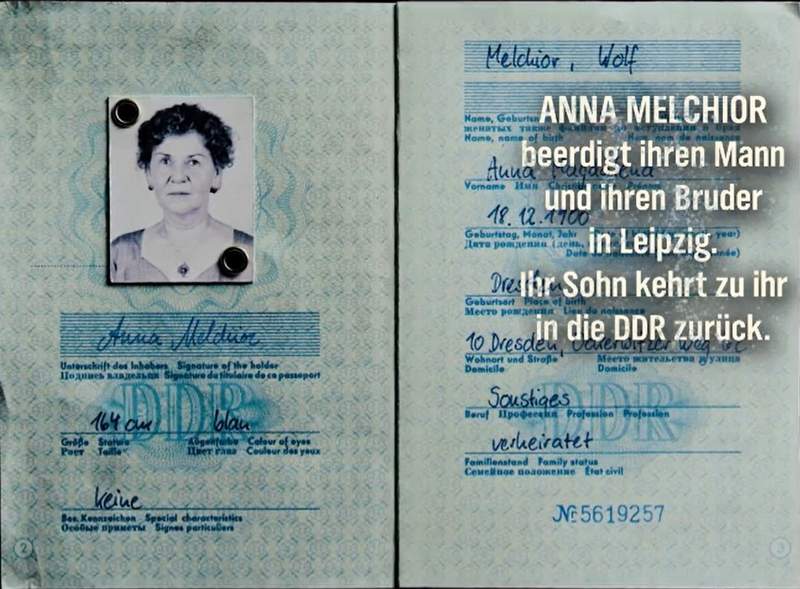Interzonal Train D151 – 13 Aug 1961 – Berlin Wall
60 Years Berlin Wall
August 13, 1961, 8:10 a.m. Interzonenzug D 151 leaves Munich on time for East Berlin. Most of the passengers are on their way back to their homeland, the GDR. Suddenly, a rumor makes the rounds on the train that the border will be closed forever. It is said that the Ulbricht regime has begun building a wall. The passengers are families with children, a music band, a commissar, a top athlete, and her trainer. They all have their past, their secrets, and their longings in their luggage. And each one of them now has three and a half hours, stop by stop, to decide of a lifetime: “Do I go back, or do I get off before the border and start over?” Time is running out.
A steam locomotive, still built during wartime, is heading east. Interzone train D-151 takes three and a half hours to cross the inner-German border between Ludwigsstadt (Bavaria) and Probstzella (Thuringia) to reach its destination in East Berlin. In Berlin, the Wall was built, making domestic German travel virtually impermeable. The Bundesbahn and the Reichsbahn were still at the controls, but the rulers of the East were setting the course for the future. For an eternity of 28 years. The people have no idea.
It is a brilliant idea of the Degeto film (movie trailer) to put the anniversary commemoration of historical brutality on the track and thus give steam to history. “3 ½ Hours” is a fictional movie through and through. Interzonal Train Berlin Wall
Between Munich and Probstzella, we experience how politics intervene in people’s lives while the tranquil Franconian countryside slides by. And nothing is the same as it was before. Despite premonitions, people are stunned when news of the construction of the Wall spreads from transistor radios on the train. Should they continue or get off?
The Küglers represent the final tearing apart of a family. The wife is an economist loyal to the Berlin Wall; the husband is a trained aircraft engineer who doesn’t want to be stuck in the East. The news of the construction of the Wall destroys their life together. He has secretly got himself a job in Munich that is suitable for training. The officer’s daughter reminds her husband of common socialist dreams. Her father is a Major in the People’s Police involved in the Wall-building operation.

Marlis Kuegler is one of the novel’s protagonists. As a communist – and the daughter of a Volkspolizei officer – she concedes to the Ulbricht regime that it had to do “something” after three million people left the GDR. At the same time, she knows that her husband has had no future as an aircraft engineer in the GDR since the crash of the “Baade 152,” the first German jet-turbine airliner, in March 1959. This air disaster really did happen. But the real disaster was what conclusions the GDR’s central economic planners drew from this. They completely shut down the GDR’s aircraft industry. Thousands of people lost their vision and their jobs.
Dreamed away. The man leaves the train before the border, takes his daughter with him, and the son continues with his mother as the film’s credits say, a farewell for 28 years with a rare reunion in Prague or at the Black Sea. Love does know boundaries. Another heartbreaking separation is that of West German Ingrid Born. The mother of a little black boy, born of an affair with a black GI, hopes for a ride to marital bliss: her son is to have a “real” father. Interzonal Train Berlin Wall
Her fiancé is a proud baker. In the Bavarian town of Ludwigsstadt, just before the GDR border, they are to be married. But when it becomes clear that this train is heading for a socialist prison, the fiancé turns out to be a fraud. He doesn’t want to become a “real” father; he already is one over in the East. He reveals himself, drives on.
It also makes you cry about what happens to the Melchior couple. The man’s inability to cope with his son’s flight to the West. He is angry and petrified. He is supposed to read a letter from his wife on the way. He is supposed to know how distraught the wife is about her husband. As the train approaches the border, hope for change and insistence on despair wage a deadly battle. Interzonal Train Berlin Wall

What does the Munich police inspector, who is constantly pulling out his badge, actually want on the train to the east? He is looking for people who have had contact with a drug doctor and finds a mysterious trainer looking after a young gymnast and hiding brown vials in a baby carriage. The trainer played brashly and tantalizingly self-assured, is allowed to travel on to the East unmolested. The inspector is lenient with the German-German authorities given the doping substances; after all, the trainer won Olympic gold in 1936. Her protégé remains in the care of the athlete-poisoner despite growing mistrust.

The story of the GDR band traveling home with the blonde singer as the leader is a bit overloaded. Should the musicians stay in the West despite their failure? What becomes of the gay love between two members? How does the singer’s Jewish boyfriend cope with his fate as a leg-amputated Nazi victim who recognizes his tormentor during the Nazi era in, of all people, the disloyal Munich baker? And the blonde is also a member of the Stasi. Interzonal Train Berlin Wall

Then there is Edith Salzmann, the first female train driver in the GDR. Her job is to pick up the Interzonal train from Thuringia in Bavaria. I saw the movie on German TV, and it’s a fantastic story based on Robert Krause’s book “3 1/2 hours”.

The Baade 152 also known as Dresden 152, VL-DDR 152 or simply 152, was a post-war airliner designed and manufactured by East German aircraft company VEB Flugzeugwerke Dresden. The aircraft was named after German aeronautical engineer Brunolf Baade, the principal designer involved in the program. It had the distinction of being the first jet airliner to be developed in Germany. Interzonal Train Berlin Wall
On 4 December 1958, the maiden flight of the prototype V1/I (DM-ZYA) took place. A total of three Baade 152s would be manufactured, two of which would participate in a test flight program based out of Dresden Airport between 1956 and 1961. On 4 March 1959, the prototype was lost in an accident, killing all crew on board; the cause is unclear. Testing continued using the second prototype. At one stage, there were reports that around 20 aircraft were in various stages of production on behalf of the East German state airline Deutsche Lufthansa. However, all flight tests of the Baade 152 were abandoned after a fuel supply problem was uncovered. The type failed to enter service, and production was terminated without any follow-on being produced. Interzonal Train Berlin Wall
*The displayed passports are not real passports!
FAQ Passport History
Passport collection, passport renewal, old passports for sale, vintage passport, emergency passport renewal, same day passport, passport application, pasaporte passeport паспорт 护照 パスポート جواز سفر पासपोर्ट
1. What are the earliest known examples of passports, and how have they evolved?
The word "passport" came up only in the mid 15th Century. Before that, such documents were safe conducts, recommendations or protection letters. On a practical aspect, the earliest passport I have seen was from the mid 16th Century. Read more...
2. Are there any notable historical figures or personalities whose passports are highly sought after by collectors?
Every collector is doing well to define his collection focus, and yes, there are collectors looking for Celebrity passports and travel documents of historical figures like Winston Churchill, Brothers Grimm, Johann Wolfgang von Goethe. Read more...
3. How did passport designs and security features change throughout different periods in history, and what impact did these changes have on forgery prevention?
"Passports" before the 18th Century had a pure functional character. Security features were, in the best case, a watermark and a wax seal. Forgery, back then, was not an issue like it is nowadays. Only from the 1980s on, security features became a thing. A state-of-the-art passport nowadays has dozens of security features - visible and invisible. Some are known only by the security document printer itself. Read more...
4. What are some of the rarest and most valuable historical passports that have ever been sold or auctioned?
Lou Gehrig, Victor Tsoi, Marilyn Monroe, James Joyce, and Albert Einstein when it comes to the most expensive ones. Read more...
5. How do diplomatic passports differ from regular passports, and what makes them significant to collectors?
Such documents were often held by officials in high ranks, like ambassadors, consuls or special envoys. Furthermore, these travel documents are often frequently traveled. Hence, they hold a tapestry of stamps or visas. Partly from unusual places.
6. Can you provide insights into the stories behind specific historical passports that offer unique insights into past travel and migration trends?
A passport tells the story of its bearer and these stories can be everything - surprising, sad, vivid. Isabella Bird and her travels (1831-1904) or Mary Kingsley, a fearless Lady explorer.
7. What role did passports play during significant historical events, such as wartime travel restrictions or international treaties?
During war, a passport could have been a matter of life or death. Especially, when we are looking into WWII and the Holocaust. And yes, during that time, passports and similar documents were often forged to escape and save lives. Example...
8. How has the emergence of digital passports and biometric identification impacted the world of passport collecting?
Current modern passports having now often a sparkling, flashy design. This has mainly two reasons. 1. Improved security and 2. Displaying a countries' heritage, icons, and important figures or achievements. I can fully understand that those modern documents are wanted, especially by younger collectors.
9. Are there any specialized collections of passports, such as those from a specific country, era, or distinguished individuals?
Yes, the University of Western Sidney Library has e.g. a passport collection of the former prime minister Hon Edward Gough Whitlam and his wife Margaret. They are all diplomatic passports and I had the pleasure to apprise them. I hold e.g. a collection of almost all types of the German Empire passports (only 2 types are still missing). Also, my East German passport collection is quite extensive with pretty rare passport types.
10. Where can passport collectors find reliable resources and reputable sellers to expand their collection and learn more about passport history?
A good start is eBay, Delcampe, flea markets, garage or estate sales. The more significant travel documents you probably find at the classic auction houses. Sometimes I also offer documents from my archive/collection. See offers... As you are already here, you surely found a great source on the topic 😉
Other great sources are: Scottish Passports, The Nansen passport, The secret lives of diplomatic couriers
11. Is vintage passport collecting legal? What are the regulations and considerations collectors should know when acquiring historical passports?
First, it's important to stress that each country has its own laws when it comes to passports. Collecting old vintage passports for historical or educational reasons is safe and legal, or at least tolerated. More details on the legal aspects are here...
Does this article spark your curiosity about passport collecting and the history of passports? With this valuable information, you have a good basis to start your own passport collection.
Question? Contact me...

